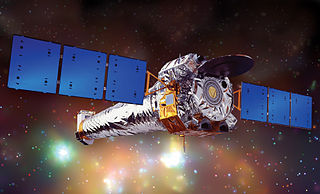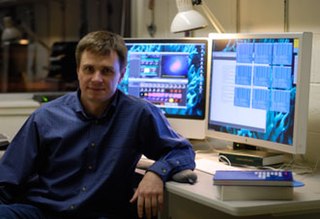
The Chandra X-ray Observatory (CXO), previously known as the Advanced X-ray Astrophysics Facility (AXAF), is a Flagship-class space telescope launched aboard the Space ShuttleColumbia during STS-93 by NASA on July 23, 1999. Chandra is sensitive to X-ray sources 100 times fainter than any previous X-ray telescope, enabled by the high angular resolution of its mirrors. Since the Earth's atmosphere absorbs the vast majority of X-rays, they are not detectable from Earth-based telescopes; therefore space-based telescopes are required to make these observations. Chandra is an Earth satellite in a 64-hour orbit, and its mission is ongoing as of 2024.
Jonathan's Space Report (JSR) is a newsletter about the Space Age hosted at Jonathan's Space Page. It is written by Jonathan McDowell, a Center for Astrophysics | Harvard & Smithsonian astrophysicist. It is updated as McDowell's schedule permits, but he tries to publish two issues each month. Originally, the website was hosted on a Harvard University account, but it was moved in late 2003 to a dedicated domain.

The Center for Astrophysics | Harvard & Smithsonian (CfA), previously known as the Harvard–Smithsonian Center for Astrophysics, is an astrophysics research institute jointly operated by the Harvard College Observatory and Smithsonian Astrophysical Observatory. Founded in 1973 and headquartered in Cambridge, Massachusetts, United States, the CfA leads a broad program of research in astronomy, astrophysics, Earth and space sciences, as well as science education. The CfA either leads or participates in the development and operations of more than fifteen ground- and space-based astronomical research observatories across the electromagnetic spectrum, including the forthcoming Giant Magellan Telescope (GMT) and the Chandra X-ray Observatory, one of NASA's Great Observatories.

Bryan Malcolm Gaensler is an Australian astronomer based at the University of California, Santa Cruz. He studies magnetars, supernova remnants, and magnetic fields. In 2014, he was appointed as Director of the Dunlap Institute for Astronomy & Astrophysics at the University of Toronto, after James R. Graham's departure. He was the co-chair of the Canadian 2020 Long Range Plan Committee with Pauline Barmby. In 2023, he was appointed as Dean of Physical and Biological Sciences at UC Santa Cruz.
Amy J. Barger is an American astronomer and Henrietta Leavitt Professor of Astronomy at the University of Wisconsin–Madison. She is considered a pioneer in combining data from multiple telescopes to monitor multiple wavelengths and in discovering distant galaxies and supermassive black holes, which are outside of the visible spectrum. Barger is an active member of the International Astronomical Union.

William Nielsen Brandt is the Verne M. Willaman Professor of Astronomy & Astrophysics and a professor of physics at the Pennsylvania State University. He is best known for his work on active galaxies, cosmological X-ray surveys, starburst galaxies, normal galaxies, and X-ray binaries.

APM 08279+5255 is a very distant, broad absorption line quasar located in the constellation Lynx. It is magnified and split into multiple images by the gravitational lensing effect of a foreground galaxy through which its light passes. It appears to be a giant elliptical galaxy with a supermassive black hole and associated accretion disk. It possesses large regions of hot dust and molecular gas, as well as regions with starburst activity.
Leon P. Van Speybroeck was an American astronomer who served as Telescope Scientist for the Chandra X-Ray Observatory, which was launched into space aboard the Space Shuttle Columbia in 1999. Van Speybroek designed the mirrors that made possible its spectacular X-ray images of nearby and remote celestial objects, including comets, exploding stars, jets of gas spewing from nearby black holes, and powerful quasars more than 10 billion light years from Earth. The data from Chandra prompted new discoveries about the evolution of stars and galaxies, the nature of the black holes, dark matter, and the shape and dimensions of the universe.

Hanny's Voorwerp is a type of astronomical object called a quasar ionization echo. It was discovered in 2007 by Dutch schoolteacher Hanny van Arkel while she was participating as a volunteer in the Galaxy Zoo project, part of the Zooniverse group of citizen science websites. Photographically, it appears as a bright blob close to spiral galaxy IC 2497 in the constellation Leo Minor.
100000 Astronautica (provisional designation 1982 SH1) is a sub-kilometer asteroid and member of the Hungaria family from the innermost region of the asteroid belt, approximately 940 meters (0.58 miles) in diameter. It was discovered on 28 September 1982, by American astronomer James Gibson at Palomar Observatory, California, United States. The likely bright E-type asteroid was named Astronautica, the Latin word for "star sailor", on the 50th anniversary of the Space Age.
Astrophysics Strategic Mission Concept Studies [AMSCS] is a program within the National Aeronautics and Space Administration agency of the United States government for possible projects leading to probable prospective missions.

Belinda Jane Wilkes is a Senior Astrophysicist at the Smithsonian Astrophysical Observatory (SAO) in Cambridge, Massachusetts, US, and former director of the Chandra X-ray Center.

Christine Jones Forman is a senior astrophysicist at the Center for Astrophysics | Harvard & Smithsonian. She is a past president of the American Astronomical Society, and was the director of the Smithsonian Institution's Consortium for Unlocking the Mysteries of the Universe.

Pictor A, around 485 million light-years away in the constellation Pictor, is a double-lobed broad-line radio galaxy and a powerful source of radio waves in the Southern Celestial Hemisphere. From a supermassive black hole at its centre, a relativistic jet shoots out to an X-ray hot spot 300,000 light-years away.

Kimberly Kowal Arcand is a data visualizer and science communicator for NASA's Chandra X-ray Observatory. She is also the visualization coordinator for the Aesthetics and Astronomy image response project at the Center for Astrophysics | Harvard & Smithsonian located in Cambridge, Massachusetts.
Giovanni Fazio is an American physicist at Center for Astrophysics | Harvard & Smithsonian. He is an astrophysicist who has initiated and participated in multiple observation programs.

Alexey Vikhlinin is a Russian-American astrophysicist notable for achievements in the astrophysics of high energy phenomenon, namely galaxy cluster cosmology and the design of space-based X-ray observatories. He is currently a senior astrophysicist at the Smithsonian Astrophysical Observatory, part of the Center for Astrophysics | Harvard & Smithsonian in Cambridge, Massachusetts. He was recently the Science and Technology Definition Team (STDT) Community Co-chair for the Lynx X-ray Observatory, a NASA-funded Large Mission Concept Study under consideration by the 2020 Decadal Survey on Astronomy and Astrophysics.

Fabio Pacucci is an Italian theoretical astrophysicist and science educator, currently at Harvard University and at the Smithsonian Astrophysical Observatory. He is widely known for his contributions to the study of black holes, in particular the first population of black holes formed in the Universe and high redshift quasars. He discovered the only two candidate direct collapse black holes known so far, and he was in the team that discovered the farthest lensed quasar known. Pacucci is also a science educator, engaged in public talks on astronomy and science in general. Since 2018 he is a collaborator of TED in developing educational videos about science. The four videos released so far were watched by millions of people worldwide and translated into 25 languages.
Aneta Siemiginowska is a Polish-American astrophysicist whose research involves high-energy cosmic objects including supermassive black hole, quasars, blazars, active galaxies, and astrophysical jets. She works at the Center for Astrophysics | Harvard & Smithsonian as a senior astrophysicist in the Chandra X-ray Center.

Grant Tremblay is an American astrophysicist notable for research on supermassive black holes, science communication, and public advocacy for large space telescopes. He is currently an Astrophysicist at the Harvard-Smithsonian Center for Astrophysics, and was formerly a NASA Einstein Fellow at Yale University, a Fellow at the European Southern Observatory (ESO), and an Astronomer at ESO's Very Large Telescope (VLT).













